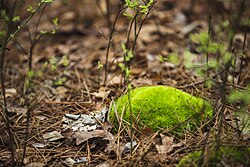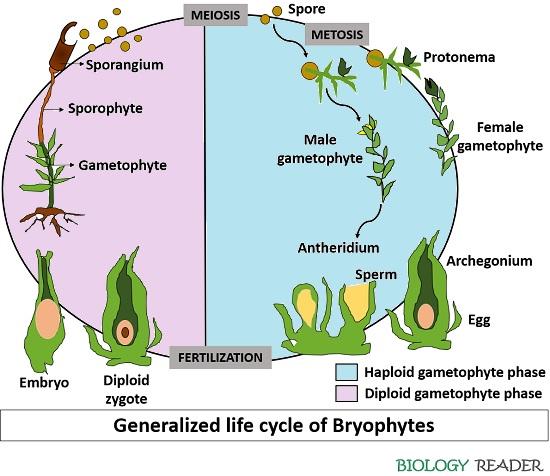Bryophyte
Bryophytes are nonvascular, seedless plants that include mosses, liverworts, and hornworts. They are widely distributed and typically small compared to seed-bearing plants. They lack true roots, stems, and leaves, and instead possess specialized structures called rhizoids, which anchor them to various surfaces and aid in water and nutrient absorption through diffusion and osmosis. They play an important role in the environment by colonizing sterile soils, absorbing nutrients and water and releasing them slowly back into the ecosystem, contributing to the new emergence of soil for plants to grow on.

Taxonomy
Bryophyte phylogeny is derived from fossil records and molecular sequencing or rRNA and morphology. There is still much unknown about the true phylogeny of this group; however, it is hypothesized that they branched off from coleochaetes, which belongs to the taxa of green algae that gave rise to vascular plant species[1].
Bryophytes belong to the division Bryophyta and are further divided into three main groups:
- Mosses (Phylum Bryophyta)
- Liverworts (Phylum Marchantiophyta)
- Hornworts (Phylum Anthocerotophyta)
Mosses are green, clump forming plants. They are known to have leaf-like structures that are only one cell in width, attached to a stem which is responsible for water and nutrient uptake. Mosses absorb a lot of water and thrive in shaded environments, which is why they are often found in wet, forested environments.
Liverworts are very small plants with flattened stem-like structures and undifferentiated leaf-like structures. They posses single-celled rhizoids, which are responsible for attaching to surfaces and nutrient/water uptake. They are different compared to the other two bryophytes due to there enclosed lipid membrane-bound bodies.
Hornworts are characterized by their long horn-like sporophytes that developed in their diploid stage. During the gametophyte stage, hornworts are flat, green plants. They are often found in damp environments.
However, new molecular evidence shows that Bryophyta are not divided into three groups, but only mosses represent the phylum Bryophyta. Hornworts and liverworts are in their own divisions, Anthocerotophyta and Marchantiophyta, respectively[1].
Characteristics
Bryophytes have many unique features, one of them being that they are small in size and can grow on many surfaces including rock surfaces. They are primarily found in damp environments, but are also found in a variety of different climates and ecosystems. They can tolerate desiccation and quickly rehydrate when water becomes available. They often form dense mats that create habitat and microclimates for many organisms.
Habitat
Bryophytes can be found in many habitats around the world, such as: wetlands, coastal areas, forests, tundras, and rocky outcrops. They thrive in damp and shady environments but can also be found in extreme environments such as deserts and the arctic [2].
Life Cycles

Bryophytes have a life cycle which consists of alternating generations of haploid gametophyte and diploid sporophyte [3]
- The gametophyte generation produces gametes through mitosis. The haploid gametes are formed in specialized sex organs, the archegonia (female) and the antheridia (male)
- The gametes are described as flagellated sperm, which have to transport through water diffusion, and then dispersed by insects.
- Fertilization occurs when sperm from antheridia fertilize eggs in archegonia.
- The zygote develops into a diploid sporophyte, which remains attached to the gametophyte (fertilized egg).
- The sporophyte produces spores through meiosis inside the sporangium.
- Spores are released, and under the right environmental conditions they will germinate into new gametophytes. This completes the life cycle.
Evolution
Bryophytes are suggested to be one of the earliest groups of land plants which evolved from aquatic environments to survive in terrestrial environments. This was estimated to have happened roughly 430 million years ago. Bryophytes played a crucial role in the colonization of land plants by providing habitat and facilitating soil formation through metabolic functions and nutrient cycling[2].
Bryophytes can be used to reveal information about how the first plants adapted in their conquest into terrestrial environments. All the existing species of bryophytes today are recent descendants of extinct bryophytes [2].
Uses
Bryophytes have various human uses and ecological significance. They help in soil formation and prevent erosion by stabilizing the soil and act as indicators of environmental health, as they are sensitive to changes in air and water quality. Bryophytes are used in horticulture for decorative purposes, such as in moss gardens or terrariums. They contribute to nutrient cycling in ecosystems by absorbing and retaining nutrients in their tissues. Some species of bryophytes have medicinal properties and have been used in traditional medicine and pharmaceutical products [4].
References
- ↑ 1.0 1.1 Bryophyte. 2023, March 31. . Encyclopædia Britannica, inc. https://www.britannica.com/plant/bryophyte.
- ↑ 2.0 2.1 2.2 Perez, J.I. “Bryophytes.” Smithsonian Tropical Research Institute, Smithsonian Tropical Research Institute, 28 Aug. 2024, https://stri.si.edu/story/bryophytes#:~:text=Bryophytes%20thrive%20in%20damp%2C%20shady,by%20spores%20instead%20of%20seeds.
- ↑ Editors, B. 2019, October 5. Bryophyte - definition, characteristics, life cycle and examples. https://biologydictionary.net/bryophyte/.
- ↑ (N.d.). . https://www.ias.ac.in/article/fulltext/reso/009/06/0056-0065.